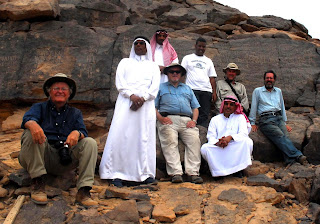During the short-three week excavation season, we had the opportunity to do some traveling in the regions of Asir and Najran, as always with a police escort.
Our archaeological site of Jurash is located on the outskirts of the city of Khamis Mushayt. We were near an airforce base, so we were repeatedly buzzed by jets during our time at the site. Curiously, lots of baboons live around the periphery of the base.
Our archaeological site of Jurash is located on the outskirts of the city of Khamis Mushayt. We were near an airforce base, so we were repeatedly buzzed by jets during our time at the site. Curiously, lots of baboons live around the periphery of the base.

The baboons of Khamis Mushayt
There are plenty of mosques around. One evening there was a partial lunar eclipse and so special prayers were held to mark the occasion. That was the first time I have come across such a practice.
We made a couple trips to the capital city of Abha, some forty minutes drive away. It, like the Asir mountains as a whole, has a mild climate, and so is a major draw for Saudis on vacation during the summer months.
We went to see a number of archaeological sites. Much of Saudi Arabia and the Asir region remain little explored. A regional survey is planned to be part of the next Jurash season. One major rock art site we saw was at Bir Hima, north of Najran at a point where the ancient trade routes bifurcated. At Bir Hima are two rock-cut inscriptions of Dhu Nuwas, the Jewish ruler of South Arabia in the 520s A.D., who was the ruler who massacred the Christians of Najran, an incident mentioned in the Quran (chapter 85, verses 4-9).
We made a couple trips to the capital city of Abha, some forty minutes drive away. It, like the Asir mountains as a whole, has a mild climate, and so is a major draw for Saudis on vacation during the summer months.
We went to see a number of archaeological sites. Much of Saudi Arabia and the Asir region remain little explored. A regional survey is planned to be part of the next Jurash season. One major rock art site we saw was at Bir Hima, north of Najran at a point where the ancient trade routes bifurcated. At Bir Hima are two rock-cut inscriptions of Dhu Nuwas, the Jewish ruler of South Arabia in the 520s A.D., who was the ruler who massacred the Christians of Najran, an incident mentioned in the Quran (chapter 85, verses 4-9).

The excavation team in front of one of the Dhu Nuwas inscriptions at Bir Hima
Our visit to Bir Hima was part of a weekend trip to Najran, where we were hosted by the Najran office of the Department of Antiquities. We saw the archaeological site of Ukhdud (old Najran) and the archaeological museum there.
 General view of the citadel area of the Ukhdud archaeological site
General view of the citadel area of the Ukhdud archaeological site The excavation team and museum staff at the Najran museum
The excavation team and museum staff at the Najran museum
Among the other noteworthy things we saw was an early 20th century mud-brick palace in Najran. Multi-story traditional mud-brick buildings remain common in the region.

The entrance to the mud-brick palace at Najran
1 comment:
Cool entries, fun to read. I particularly like the modern day mudbrick building.
There seems to be a lack of women-folk in the pictures. Hmmmm, curious ;-)
If you're celebrating Ramadan, I hope it's an easy fast.
Post a Comment